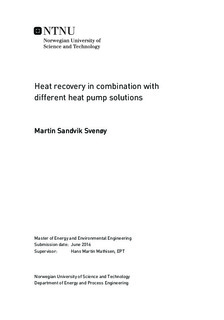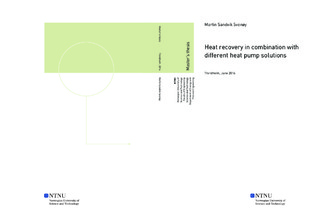| dc.description.abstract | Abstract
The aim for this Master s thesis has been to investigate and compare the performance of different methods for heat recovery from exhaust ventilation air. Energy efficiency of using a heat exchanger is compared to commercial exhaust heat pump (EAHP) products. The heat pump units include accumulation tank so that they can supply domestic hot water and space heating. A life cycle costing (LCC) comparison between the solutions has been made. The basis for the simulation is a single-unit dwelling that could accommodate a family of four with an internal area of 115 m2. The house is built according to the Norwegian passive house standard.
Five different systems were simulations in IDA Indoor Climate and Energy with two different climates, the cities of Trondheim and Kautokeino. One of the system analyzed have passive heat recovery and electric heaters for addition space heating and DHW. Three of the systems are based on exhaust heat pumps, two from NIBE (F470 and F110) and one from Nilan (Compact P Nordic). The last system is a reference system were electric heaters covers the entire demand.
Without any heat recovery, the total energy demand for ventilation and heating was 106,3 kWh/(m2*year) in Trondheim and 180,3 kWh/(m2*year) in Kautokeino. Heat recovery with 80% efficiency and a minimum discharge air temperature of 5 oC reduced the energy demand to 56,5 kWh/(m2*year) and 104,6 kWh/(m2*year), in Trondheim and Kautokeino respectfully. Heat recovery reduces the delivered energy of 46,8% in Trondheim and 42,0% in Kautokeino. The most energy efficient system was the exhaust air heat pump unit Compact P Nordic from Nilan. The delivered energy for ventilation and heating was reduced by 62,2%, down to 40,1 kWh/(m2*year) in Trondheim. And in Kautokeino the delivered energy was reduced by 47,6%, down to 94,5 kWh/(m2*year).
The LCC compare the total annual cost for the five systems. The comparison include annual energy cost and the investment cost for the heating system, ventilation and heat pump units. A calculation tool called LCCWeb was used to calculate the costs.
The cheapest system was the one with only passive heat recovery with an annual cost of 16 856 NOK/year, 17,73% lower than the reference system, for a building in Trondheim. The most expensive system was the EAHP F470 from NIBE with an annual cost 6,86% higher than the reference system, at 18 012 NOK/year. | |

